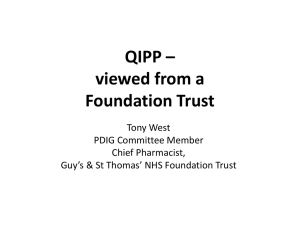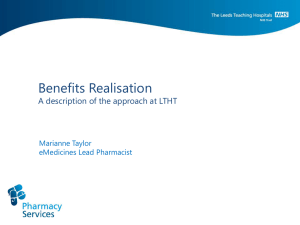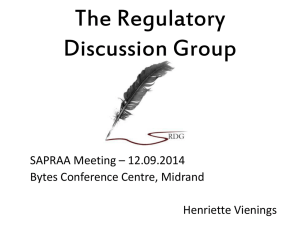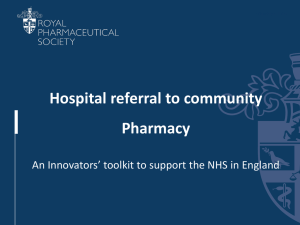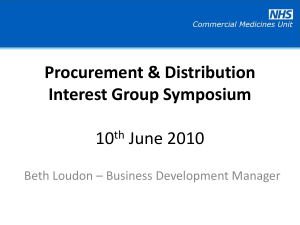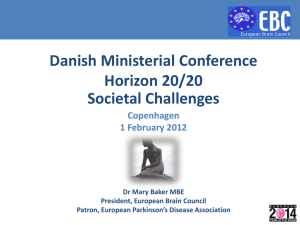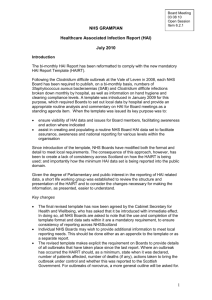South Central - Patient Safety Federation
advertisement
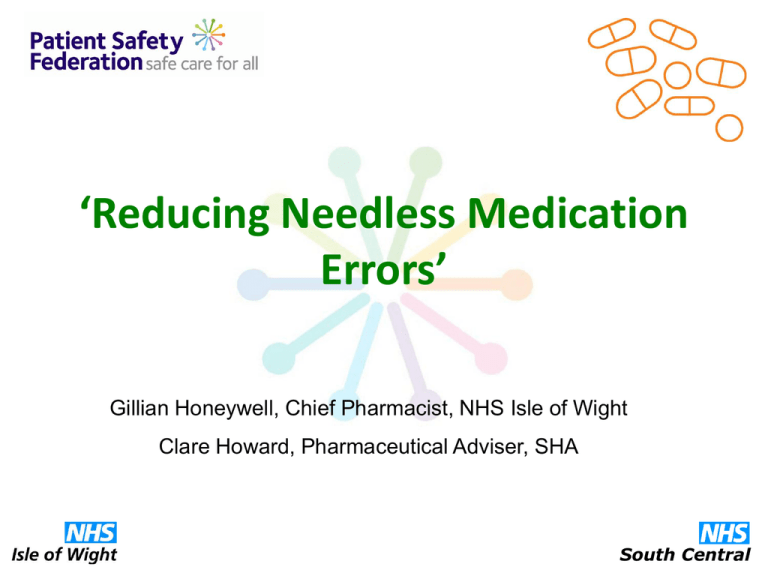
‘Reducing Needless Medication Errors’ Gillian Honeywell, Chief Pharmacist, NHS Isle of Wight Clare Howard, Pharmaceutical Adviser, SHA South Central Medication Errors do happen.. South Central Reported incident types in England April 2008 to March 2009 Medication 86,287 NPSA ‘Patient Safety Incidents in the NHS’ 2009 South Central Facts and figures • Medicines are the most frequently used healthcare intervention • 97% of all hospital patients take a medicine • 6% of hospital admissions are a direct result of problems with medicines including side effects1 • Poor communication between care settings is responsible for up to 50% of all medication errors & up to 20% of adverse drug reactions that occur in hospital 2 • Average DGH has 350 medication errors per day 1. 2. Pharmacy in England Building on strengths – delivering the future, Department of Health. 2008 NICE/NPSA patient safety guidance to improve medicines reconciliation at hospital admission. National Patient Safety Agency. December 12 2007 available from http/www.npsa.nhs.uk/corporate/news/guidance-to-improve-mrdicines-reconciliation/ South Central Metrics Metric 1: Means of ensuring patient receive oral anticoagulation therapy within safe parameters (INR >5 & >8) Metric 2: Medicines reconciliation: safer admission to hospital and ensuring that patients’ medicines are reconciled within 24 hours of admission Metric 3: Allergies: A means of ensure that patients allergy status is recorded on prescription charts Metric 4: SCIP 2 - Promoting the safer use of injectable medicines Metric 5: Reduce the number of preventable NSAID related harms Metric 6: Reduction of harm from omitted and delayed medicines in hospital Metric 7: Reduce the number of insulin dosage errors caused by inappropriate use of abbreviations South Central South Central Patient Safety Summary Data Average % of Adult Patients with Allergy Status Documented Average % of Adult Patients with Medicines Reconciliation Completed within 24 hrs 100% 100% 95% 90% 85% 80% 75% 70% 65% 60% 55% 50% 90% 80% 70% 60% 50% 40% 30% Average % of Adult Patients with INR >5 Average % of Adult Patients with INR >8 12.0% 6.0% 10.0% 5.0% 8.0% 4.0% 6.0% 3.0% 4.0% 2.0% 2.0% 1.0% 0.0% 0.0% Metric 1: INR>5 & INR >8 Percentage of warfarin patients with an INR 5.0 + at the ORH & NOC Special cause effect Oct-10 Sep-10 Aug-10 Jul-10 Jun-10 May-10 Apr-10 Mar-10 Feb-10 Jan-10 Dec-09 Nov-09 Oct-09 Sep-09 Aug-09 Jul-09 Jun-09 May-09 Apr-09 Mar-09 0 Feb-09 2 Jan-09 mean 4 Dec-08 lower control limit 6 percentage percentage of warfarin patients with an INR 5.0 + upper control limit Dec-08 Jan-09 Feb-09 Mar-09 Apr-09 May-09 Jun-09 Jul-09 Aug-09 Sep-09 Oct -09 Nov-09 Dec-09 Jan-10 Feb-10 Mar-10 Apr-10 May-10 Jun-10 Jul-10 Aug-10 Sep-10 Oct -10 Percentage of warfarin patients with an INR 8.0 + at the ORH & NOC 2.97 3.92 3.50 3.06 3.23 2.73 2.96 4.545 4.545 4.545 4.545 4.545 4.545 4.545 4.545 Oxford Radcliffe Hospitals 2.90 3.31 4.06 4.80 3.60 3.04 2.76 3.27 3.01 3.22 2.64 3.14 2.50 4.545 4.545 4.545 4.545 4.545 4.545 4.545 4.545 4.545 4.545 4.545 4.545 4.545 1.87 1.87 1.87 1.87 1.87 1.87 1.87 1.87 1.87 1.87 1.87 1.87 1.87 1.87 1.87 1.87 1.87 1.87 1.87 1.87 1.87 1.87 3.207 3.207 3.207 3.207 3.207 3.207 3.207 3.207 3.207 3.207 3.207 3.207 3.207 3.207 3.207 3.207 3.207 3.207 3.207 3.207 3.207 3.207 Oct-10 Sep-10 Aug-10 Jul-10 Jun-10 May-10 Apr-10 Jan-10 Dec-09 Nov-09 Jul-09 Jun-09 May-09 Apr-09 Mar-09 Feb-09 Jan-09 Dec-08 Oct-09 month / year 1.50 1.00 0.50 0.00 2.54 4.545 Sep-09 2.00 3.207 Percentage percentage of warfarin patients with an INR 8.0 + Upper limit mean Aug-09 1.87 lower cont rol limit 4.545 Mar-10 3.40 upper cont rol limit Feb-10 percent age of warf arin pat ient s wit h an INR 5.0 + Dec- Jan- Feb- Mar- Apr- May- Jun- Jul- Aug- Sep- Oct- Nov- Dec- Jan- Feb- Mar- Apr- May- Jun- Jul- Aug- Sep- Oct08 09 09 09 09 09 09 09 09 09 09 09 09 10 10 10 10 10 10 10 10 10 10 percentage of w arfarin patients w ith an INR 8.0 + 1.16 0.78 1.24 0.82 0.82 1.21 0.82 0.83 South Central 0.73 0.56 0.64 0.90 1.16 0.59 0.74 0.62 0.94 0.72 0.93 0.50 0.84 1.02 Metric 2: Medicines Reconciliation % of Adult Patients with Medicines Reconciliation Completed within 24 hrs 100% 90% Implementation of 7 Day Working Target line 80% 70% 60% 50% 40% 30% 20% Staff vacancies 10% Implementation of Green Bag Scheme 0% Jan-10 Feb-10 M ar -10 A pr -10 M ay-10 M ay(2) Jun-10 June(2) Jul -10 Jul (2) A ug-10 Sep-10 Oct -10 Nov-10 Dec-10 NHS Isle of Wight South Central Green Bag Scheme • £20,000 Pump Prime PSF • Improves Medicines reconciliation by supporting the safe transfer of patient’s medicines between care settings • Scheme has been rolled out throughout the South Central region • Collaboration with 2 other regions on tendering process is currently underway to achieve best value for money South Central Metric 3: Allergy Status Target line New doctors Increased intervention effort by pharmacists New doctorsimproved induction on allergy status New prescription chart Berkshire Healthcare NHSFoundation Trust South Central Metric 4: Safer Use of Injectable Medicines: SCIP2 Focus on practical implementation of targeted products identified by NPSA alert 20: • Dobutamine 250mg in 50ml vial • Morphine 1mg/ml & 2mg/ml – 50ml vial • Human soluble insulin 50 units in 50ml pre-filled syringe •Chief Pharmacists signed up to implement within agreed timescales •Practical ‘How to guides’ produced for each product (see Workstream stand) •Progress assessed by purchasing data, questionnaire & liaison with manufacturing unit South Central South Central Next steps………… ‘Moving on from a culture of measuring and benchmarking to action’ • PDSA cycle for current metrics & sharing of good practice • Medicines Management training – to provide a standardised training kit for all involved in medicines management • Work is underway on following metrics: – NSAIDS related harms – Omitted & delayed medicines in hospital – Reducing the number of insulin dosage errors caused by inappropriate use of abbreviations • NNME workstream annual conference on the 12th & 13th May 2011 Isle of Wight ‘Moving on from a culture of measuring and benchmarking to action’ South Central PSF to QIPP? • Medicines are the most frequently used healthcare intervention = £12 billion (11%) of overall NHS budget (South Central = £777 million) • Avoidable medication errors costs the NHS in England £750million (South Central = £58million)1 1. NPSA Patient Safety Observatory ‘Safety in doses: medication safety incidents in the NHS’ South Central Safety Metrics & QIPP • What is the economic impact of improving safety in the areas selected? • Initially, we set out to reduce medication related incidents by 20% which could (crudely) indicate savings of roughly £12 million per year. • Does it add up? Can we QIPP the patient safety agenda? With medication errors we think we can South Central Next steps Some of the assumptions need to be tested locally…….. • • • • • Costs and Meds Rec rates before and after green bags? How many INR > 8 result in an admission? What does it cost your Trust to treat a drug induced bleed? Can we determine the cost of omitted doses? How many admissions per year by Trust for insulin induced hypoglycaemia? • Will “cost avoidance” fall on deaf ears? South Central For more information on the ‘Reducing Needless Medication Errors Workstream’ please see the Patient Safety Federation website www.patientsafetyfederation.uk or contact Fiona Eccleston- Project Manager Fiona.eccleston@iow.nhs.uk South Central
